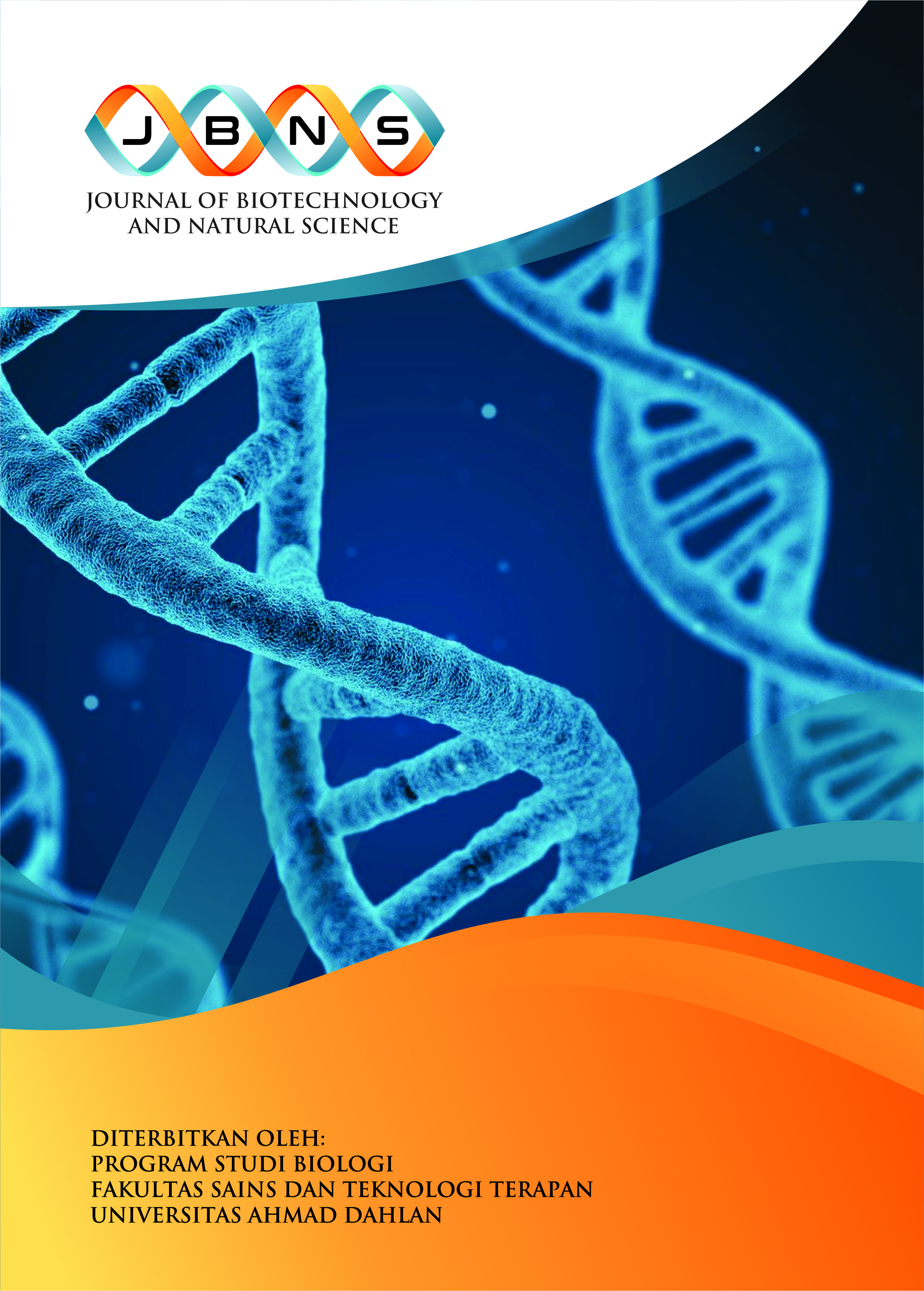In Vitro Evaluation of Antioxidant and Lipase Inhibition Properties of Rosella (Hibiscus sabdariffa L.) Flower Kombucha
DOI:
https://doi.org/10.12928/jbns.v4i2.11271Keywords:
Antioxidant, Fermentation, Kombucha, Lipase Inhibition, Rosella FlowerAbstract
Kombucha, a traditional fermented beverage made from tea, sugar, and a kombucha culture, is known for its unique flavor, aroma, and health benefits. The fermentation process, typically lasting between 8 and 12 days, influences the beverage's physical and chemical properties. While traditionally brewed from tea, alternative substrates like rosella flowers (Hibiscus sabdariffa L.) are also used. Rosella flowers, rich in vitamins and bioactive compounds, have demonstrated potential in combating obesity and exhibiting antioxidant properties. This study aimed to evaluate the chemical and biological characteristics of rosella flower kombucha, particularly its antioxidant and lipase inhibitor activities. The fermentation process led to significant biochemical changes, including a decrease in pH and reducing sugar content, an increase in microbial biomass, and a reduction in ascorbic acid content. The results revealed that rosella flower kombucha had a higher total phenol content and better DPPH radical scavenging activity compared to rosella flower infusion, indicating enhanced antioxidant potential. Additionally, rosella kombucha demonstrated more effective lipase inhibition, suggesting its potential benefits for weight management and metabolic health. These findings emphasize rosella kombucha's potential as a healthful functional beverage, recommending further research in these areas.
References
Agbor, G. A., Vinson, J. A., & Donnelly, P. E. (2014). Folin-Ciocalteau reagent for polyphenolic assay. International Journal of Food Science, Nutrition and Dietetics (IJFS), 3, 1-10. https://doi.org/10.19070/2326-3350-1400028
Ahmed, S., Mohamed, S., Hikal, M., Khadiga, A., & Abou-Taleb, M. (2020). Biological, chemical and antioxidant activities of different types Kombucha. Annals of Agricultural Sciences, 65, 35-44. https://doi.org/10.1016/j.aoas.2020.04.001
Aji, O. R., Putri, N. F., & Putri, D. A. (2023). Pancreatic lipase inhibitory activity of butterfly pea flower (Clitoria ternatea) Kombucha. Biogenesis Jurnal Ilmiah Biologi, 11(2), 151–159. https://doi.org/10.24252/bio.v11i2.35724
Ariani, L. W., Ungsari, R. E. P., & Mighfar, S. (2019). Formulasi mikropartikel ekstrak etanol bunga rosela (Hibiscus Sabdariffa L.) dalam sediaan sirup dan potensinya sebagai obat herbal antiobesitas. Jurnal Ilmiah Cendekia Eksakta, 4, 1.
Cardoso, R. R., Neto, R. O., D'Almeida, C. T. D. S., Nascimento, T. P. D., Pressete, C. G., Azevedo, L., Martino, H. S. D., Cameron, L. C., Ferreira, M. S. L., & De Barros, F. A. R. (2020). Kombuchas from green and black teas have different phenolic profiles, which impacts their antioxidant capacities, antibacterial and antiproliferative activities. Food Research International, 128, 108782. https://doi.org/10.1016/j.foodres.2019.108782
Charoenrak, S., Charumanee, S., Sirisa-Ard, P., Bovonsombut, S., Kumdhitiahutsawakul, L., Kiatkarun, S., Pathom-Aree, W., Chitov, T., & Bovonsombut, S. (2023). Nanobacterial cellulose from Kombucha fermentation as a potential protective carrier of Lactobacillus plantarum under simulated gastrointestinal tract conditions. Polymers, 15(6), 1356. https://doi.org/10.3390/polym15061356
Cohen, G., Sela, D. A., & Nolden, A. A. (2023). Sucrose concentration and fermentation temperature impact the sensory characteristics and liking of kombucha. Foods, 12(16), 3116. https://doi.org/10.3390/foods12163116
Gruenwald, J., Brendler, T., & Jaenicke, C. (2004). PDR for herbal medicines, third edition. Medical Economics Company, New Jersey.
Jafarpour, D., & Hashemi, S. M. B. (2023). Pure and co-fermentation of quinoa seeds by Limosilactobacillus fermentum and Lacticaseibacillus rhamnosus: Bioactive content, antidiabetic and antioxidant activities. Fermentation, 9(2), 80. https://doi.org/10.3390/fermentation9020080
Jayabalan, R., Malbaša, R. V., Lončar, E. S., Vitas, J. S., & Sathishkumar, M. (2014). A review on kombucha tea: Microbiology, composition, fermentation, beneficial effects, toxicity, and tea fungus. Comprehensive Reviews in Food Science and Food Safety, 13, 538-550. https://doi.org/10.1111/1541-4337.12073
Kim, D. H., Park, Y. H., Lee, J. S., Jeong, H. I., Lee, K. W., & Kang, T. H. (2020). Antiobesity effect of DKB-117 through the inhibition of pancreatic lipase and α-amylase activity. Nutrients, 12, 3053. https://doi.org/10.3390/nu12103053
Kushargina, R., Rimbawan, R., Dewi, M., & Damayanthi, E. (2024). Effect of sugar addition and fermentation process on flavonoids, phenols, and antioxidant activity of Telang (Clitoria ternatea L.) kombucha. Tropical Journal of Natural Product Research, 8(3). https://doi.org/10.26538/tjnpr/v8i3.39
Naland, P. (2008). Kombucha teh dengan seribu khasiat. Agromedia Pustaka, Jakarta.
Nerdy, N. (2014). In silico docking of chemical compounds from roselle calyces (Hibiscus Sabdariffa L.) as antidiabetic. International Journal of ChemTech Research, 7, 148-152.
Nopiyanti, D., & Harjanti, A. (2016). Analisis stabilitas senyawa aktif antioksidan kelopak bunga rosella (Hibiscus sabdariffa L.) pada penggunaannya sebagai bahan tambahan pangan alami. Jurnal Farmasi Indonesia, 13, 101-110.
Sari, P. (2014). Perbandingan aktivitas antioksidan kombucha teh hijau (Camelia sinensis) dengan teh daun mangga (Mangifera indica) dipengaruhi oleh lama fermentasi. Skripsi. Surakarta: Universitas Muhammadiyah Surakarta.
Susilowati, T. (2013). Perbedaan waktu fermentasi dalam pembuatan teh kombucha dari ekstrak teh hijau lokal Arraca kiara, Arraca yabukita, Pekoe dan Dewata sebagai minuman fungsional untuk antioksidan. Prosiding SNST ke-4. Semarang: Universitas Wahid Hasyim.
Wang, B., Rutherfurd-Markwick, K., Naren, N., Zhang, X., & Mutukumira, A. N. (2023). Microbiological and physico-chemical characteristics of black tea kombucha fermented with a New Zealand starter culture. Foods, 12(12), 2314. https://doi.org/10.3390/foods12122314
Windyaswari, A. (2018). Pengaruh teknik dan pelarut ekstraksi terhadap aktivitas antioksidan dan empat jenis ekstrak daun rosella (Hibiscus Sabdariffa. L.). TM Conference Series, 1, 14-1. https://doi.org/10.32734/tm.v1i3.254
Downloads
Published
Issue
Section
License
Copyright (c) 2024 Oktira Roka Aji, Anas Tasya Putri, Erisa Budi Handayani, Nisa Ihsani

This work is licensed under a Creative Commons Attribution-ShareAlike 4.0 International License.

